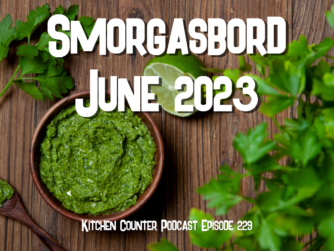Download the episode MP3 (right click to save)
Food Safety Basics
A suggestion came in on our Facebook page from Jennifer to talk about leftovers and how to safely store them. That got me thinking about food safety in general, so I decided to devote this episode to talking about good food safety practices to practice in the home kitchen.
One in six Americans will get sick from food poisoning this year. That means that in some point in your life you’ve probably been sickened by food whether you realize it or not. I’ve been hospitalized because of foodborne bacteria I picked up in a restaurant, and let me tell you, it isn’t fun!
I’m going to break this down into three parts: Food prep, cooking, and storing leftovers.
By the way, foodsafety.gov is an excellent website with tons of practical info for use in your kitchen including cooking temperature and storage charts.
First of all, you should understand what foods are cause for concern when it comes to food safety:
Safely Preparing Foods
Poultry, meats, seafood, eggs, and raw milk dairy products cause the most concern when it comes to bacteria.
The keys to properly handling your prep foods are:
– Wash your hands often!
– Keep your risky foods (meats, poultry, seafood, etc.) separated from your not so risky foods (vegetables, fruits, grains, etc), to avoid cross contamination.
– I recommend having different cutting boards for different types of food so you can make sure you aren’t dicing onions on the same board you just cut up raw chicken! Also be sure to properly clean all utensils between ingredients.
– Don’t thaw or marinate meat at room temperature.
– When you are done prepping, clean up your area thoroughly before starting in on cooking.
Cooking Your Food Properly
This phase is mainly concerned with cooking your foods to a proper temperature to kill bacteria and therefore make the food safe to eat. You should get a hold of a good cooking time/temp chart (the one from foodsafety.gov is perfectly fine). The other key is to get yourself a good food thermometer. My favorites are the instant-read digital types, but here are three different ones to check out.
Insta-Read Large Dial Cooking Thermometer
Commercial Waterproof Digital Thermometer (great all-around thermometer)
The Cadillac of food thermometers
Also remember not to double-dip when you taste your food–You’ll transfer nasty mouth bacteria to the food!
Storing leftovers
Bacteria grows most rapidly between the temps of 40F and 140F degrees. You should get leftovers in the fridge ASAP–it’s generally not a good idea to let them cool at room temp for any period of time. Try to accelerate cooling by increasing the surface area of food before putting in fridge (put hot liquids in shallow bowls, and cut up meat into smaller pieces). This will also help ensure you won’t heat up items that are already in the fridge. Also note that the back of your fridge will be the coolest, and therefore the best place to put leftovers.
You should only reheat leftovers that you plan on eating. Don’t reheat, then cool, reheat, then cool. Also, reheat to full temp (165F) to kill any bacteria that has accumulated.
Only keep leftovers in your fridge for about 3-4 days before tossing. Remember, just because something smells or looks “ok” doesn’t mean it doesn’t have bacteria that can make you sick! When it doubt, throw it out!
Food Safety Resources
foodsafety.gov– U.S. government website with tons of resources on food safety. Also lists food recall information
Interesting article on reheating leftover meat
USDA website for food safety and security
Home food safety booklet download
Connect with The Kitchen Counter Podcast!
Leave me voice mail feedback at: 971-208-5493
Facebook: https://www.facebook.com/kitchencounterpodcast
Twitter: @TKCpodcast
Email:
fe******@ki*******************.com
If you liked what you heard, please consider subscribing in iTunes. You can also help out the show by leaving a positive review in the iTunes store (you know you want to)!



